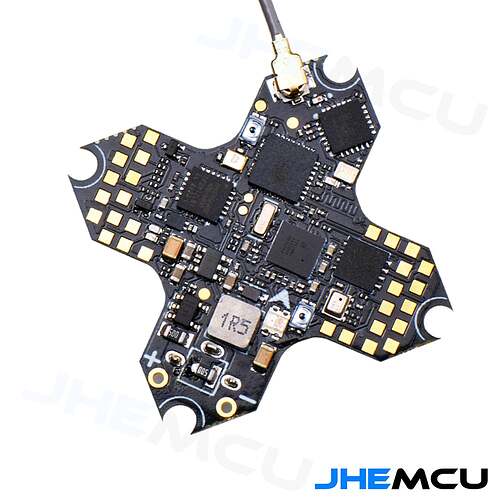I’ve done a little work on creating a new target for this board. This is a WIP and untested.
Goal is to have bidirectional DShot support, DMA on USART1 (on-board ELRS, uses CRSF protocol), USART3 (for GPS), and UART6. I have a timer assigned to the LED_STRIP pin, but don’t know if TIM1_UP is sufficient for WS2812 use.
What is the correct value of HAL_STORAGE_SIZE for 8M onboard flash?
hwdef.dat:
# hw definition file for processing by chibios_pins.py
# JHEMCU GSF405A
# With F405 MCU, MPU6000 IMU and 7456 series OSD
# Based on Mamba F405 from jeanphilippehell
@ thanks to betaflight for pin information
MCU STM32F4xx STM32F405xx
# board ID for firmware load
APJ_BOARD_ID 1060
# crystal frequency
OSCILLATOR_HZ 8000000
# board voltage
STM32_VDD 330U
define STM32_ST_USE_TIMER 4
define CH_CFG_ST_RESOLUTION 16
# order of I2C buses
I2C_ORDER I2C1
# order of UARTs (and USB)
# this order follows the labels on the board
SERIAL_ORDER OTG1 USART1 USART2 USART3 UART4 EMPTY USART6
# The pins that USB is connected on
PA11 OTG_FS_DM OTG1
PA12 OTG_FS_DP OTG1
PC5 VBUS INPUT OPENDRAIN
# USART1 (DMA) - wired to on-board ELRS receiver - need DMA for CRSF protocol
PB6 USART1_TX USART1
PA10 USART1_RX USART1
# Alt config to allow PPM on RX1
#PA10 TIM1_CH3 TIM1 RCININT PULLDOWN ALT(1)
# USART2
PD5 USART2_TX USART2 NODMA
PD6 USART2_RX USART2 NODMA
# USART3 (DMA) - Use for GPS as it is close to I2C pins.
PB10 USART3_TX USART3
PB11 USART3_RX USART3
# UART4
PA0 UART4_TX UART4
PA1 UART4_RX UART4 NODMA
# USART6 (DMA)
PC6 USART6_TX USART6
PC7 USART6_RX USART6
# ADC
PC3 BAT_VOLT_SENS ADC1 SCALE(1)
PC0 RSSI_IN ADC1
PC2 BAT_CURR_SENS ADC1 SCALE(1)
# Motor outputs on AIO ESC
PB0 TIM3_CH3 TIM3 PWM(1) GPIO(50)
PB1 TIM3_CH4 TIM3 PWM(2) GPIO(51) BIDIR
PA3 TIM5_CH4 TIM5 PWM(3) GPIO(52) BIDIR
PA2 TIM5_CH3 TIM5 PWM(4) GPIO(53)
# Board LEDs
PC14 LED1 OUTPUT LOW GPIO(1)
#PC14 LED2 OUTPUT LOW GPIO(2)
define HAL_GPIO_A_LED_PIN 1
#define HAL_GPIO_B_LED_PIN 2
# Assign timer to LED_STRIP
#PA9 LED_EXT1 OUTPUT GPIO(30)
PA9 TIM1_CH2 TIM1 PWM(5) GPIO(54)
DMA_PRIORITY SPI3*
DMA_NOSHARE USART1*
# Buzzer
PC13 BUZZER OUTPUT GPIO(80) LOW
define HAL_BUZZER_PIN 80
define HAL_BUZZER_ON 1
define HAL_BUZZER_OFF 0
# I2C1
PB8 I2C1_SCL I2C1
PB9 I2C1_SDA I2C1
# SPI1 - Internal IMU
PB12 MPU6000_CS CS
PA5 SPI1_SCK SPI1
PA6 SPI1_MISO SPI1
PA7 SPI1_MOSI SPI1
# SPI2 - none
#PB13 SPI2_SCK SPI2
#PB14 SPI2_MISO SPI2
#PB15 SPI2_MOSI SPI2
# SPI3 - OSD + 8MB flash
PC10 SPI3_SCK SPI3
PC11 SPI3_MISO SPI3
PC12 SPI3_MOSI SPI3
# OSD max7456
PB14 OSD_CS CS
# Dataflash 8MB on-board
PB3 FLASH_CS CS
# SPI Device table
SPIDEV mpu6000 SPI1 DEVID1 MPU6000_CS MODE3 1*MHZ 4*MHZ
SPIDEV dataflash SPI3 DEVID2 FLASH_CS MODE3 32*MHZ 32*MHZ
SPIDEV osd SPI3 DEVID3 OSD_CS MODE0 10*MHZ 10*MHZ
# One IMU rotated in yaw
IMU Invensense SPI:mpu6000 ROTATION_YAW_180
# Probe for I2C BMP280, but allow init on board variants without onboard baro too
BARO BMP280 I2C:0:0x76
define HAL_PROBE_EXTERNAL_I2C_BAROS
define HAL_BARO_ALLOW_INIT_NO_BARO
# no built-in compass, but probe the i2c bus for all possible
# external compass types
define ALLOW_ARM_NO_COMPASS
define HAL_COMPASS_DEFAULT HAL_COMPASS_NONE
define HAL_PROBE_EXTERNAL_I2C_COMPASSES
define HAL_I2C_INTERNAL_MASK 0
define HAL_COMPASS_AUTO_ROT_DEFAULT 2
# enable logging to dataflash
define HAL_LOGGING_DATAFLASH
#Is this correct for 8M onboard flash?
define HAL_STORAGE_SIZE 7168
STORAGE_FLASH_PAGE 1
# flash size
FLASH_SIZE_KB 1024
# reserve 16k for bootloader and 32k for flash storage
FLASH_RESERVE_START_KB 48
# define default battery setup
define HAL_BATT_VOLT_PIN 11
define HAL_BATT_CURR_PIN 13
define HAL_BATT_VOLT_SCALE 11
define HAL_BATT_CURR_SCALE 17
# Analog RSSI pin (also could be used as analog airspeed input)
define BOARD_RSSI_ANA_PIN 1
# Setup for OSD
define OSD_ENABLED 1
define HAL_OSD_TYPE_DEFAULT 1
# Font for OSD
ROMFS_WILDCARD libraries/AP_OSD/fonts/font*.bin
hwdef.txt (3.5 KB)
hwdef.h
hwdef.h (56.5 KB)
DMA Assignments snippet:
// auto-generated DMA mapping from dma_resolver.py
#define STM32_ADC_ADC1_DMA_STREAM STM32_DMA_STREAM_ID(2, 4)
#define STM32_ADC_ADC1_DMA_CHAN 0
#define STM32_I2C_I2C1_RX_DMA_STREAM STM32_DMA_STREAM_ID(1, 5)
#define STM32_I2C_I2C1_RX_DMA_CHAN 1
#define STM32_I2C_I2C1_TX_DMA_STREAM STM32_DMA_STREAM_ID(1, 6) // shared TIM5_UP,I2C1_TX
#define STM32_I2C_I2C1_TX_DMA_CHAN 1
#define STM32_SPI_SPI1_RX_DMA_STREAM STM32_DMA_STREAM_ID(2, 0)
#define STM32_SPI_SPI1_RX_DMA_CHAN 3
#define STM32_SPI_SPI1_TX_DMA_STREAM STM32_DMA_STREAM_ID(2, 3)
#define STM32_SPI_SPI1_TX_DMA_CHAN 3
#define STM32_SPI_SPI3_RX_DMA_STREAM STM32_DMA_STREAM_ID(1, 0)
#define STM32_SPI_SPI3_RX_DMA_CHAN 0
#define STM32_SPI_SPI3_TX_DMA_STREAM STM32_DMA_STREAM_ID(1, 7)
#define STM32_SPI_SPI3_TX_DMA_CHAN 0
#define STM32_TIM_TIM1_UP_DMA_STREAM STM32_DMA_STREAM_ID(2, 5)
#define STM32_TIM_TIM1_UP_DMA_CHAN 6
#define STM32_TIM_TIM3_CH4_DMA_STREAM STM32_DMA_STREAM_ID(1, 2) // shared TIM3_UP,TIM3_CH4
#define STM32_TIM_TIM3_CH4_DMA_CHAN 5
#define STM32_TIM_TIM3_UP_DMA_STREAM STM32_DMA_STREAM_ID(1, 2) // shared TIM3_UP,TIM3_CH4
#define STM32_TIM_TIM3_UP_DMA_CHAN 5
#define STM32_TIM_TIM5_CH4_DMA_STREAM STM32_DMA_STREAM_ID(1, 3) // shared USART3_TX,TIM5_CH4
#define STM32_TIM_TIM5_CH4_DMA_CHAN 6
#define STM32_TIM_TIM5_UP_DMA_STREAM STM32_DMA_STREAM_ID(1, 6) // shared TIM5_UP,I2C1_TX
#define STM32_TIM_TIM5_UP_DMA_CHAN 6
#define STM32_UART_UART4_TX_DMA_STREAM STM32_DMA_STREAM_ID(1, 4)
#define STM32_UART_UART4_TX_DMA_CHAN 4
#define STM32_UART_USART1_RX_DMA_STREAM STM32_DMA_STREAM_ID(2, 2)
#define STM32_UART_USART1_RX_DMA_CHAN 4
#define STM32_UART_USART1_TX_DMA_STREAM STM32_DMA_STREAM_ID(2, 7)
#define STM32_UART_USART1_TX_DMA_CHAN 4
#define STM32_UART_USART3_RX_DMA_STREAM STM32_DMA_STREAM_ID(1, 1)
#define STM32_UART_USART3_RX_DMA_CHAN 4
#define STM32_UART_USART3_TX_DMA_STREAM STM32_DMA_STREAM_ID(1, 3) // shared USART3_TX,TIM5_CH4
#define STM32_UART_USART3_TX_DMA_CHAN 4
#define STM32_UART_USART6_RX_DMA_STREAM STM32_DMA_STREAM_ID(2, 1)
#define STM32_UART_USART6_RX_DMA_CHAN 5
#define STM32_UART_USART6_TX_DMA_STREAM STM32_DMA_STREAM_ID(2, 6)
#define STM32_UART_USART6_TX_DMA_CHAN 5
// Mask of DMA streams which are shared
#define SHARED_DMA_MASK ((1U<<STM32_DMA_STREAM_ID(1,2))|(1U<<STM32_DMA_STREAM_ID(1,3))|(1U<<STM32_DMA_STREAM_ID(1,6)))
// generated UART DMA configuration lines
#define STM32_USART1_RX_DMA_CONFIG true, STM32_UART_USART1_RX_DMA_STREAM, STM32_UART_USART1_RX_DMA_CHAN
#define STM32_USART1_TX_DMA_CONFIG true, STM32_UART_USART1_TX_DMA_STREAM, STM32_UART_USART1_TX_DMA_CHAN
#define STM32_USART2_RX_DMA_CONFIG false, 0, 0
#define STM32_USART2_TX_DMA_CONFIG false, 0, 0
#define STM32_USART3_RX_DMA_CONFIG true, STM32_UART_USART3_RX_DMA_STREAM, STM32_UART_USART3_RX_DMA_CHAN
#define STM32_USART3_TX_DMA_CONFIG true, STM32_UART_USART3_TX_DMA_STREAM, STM32_UART_USART3_TX_DMA_CHAN
#define STM32_UART4_RX_DMA_CONFIG false, 0, 0
#define STM32_UART4_TX_DMA_CONFIG true, STM32_UART_UART4_TX_DMA_STREAM, STM32_UART_UART4_TX_DMA_CHAN
#define STM32_USART6_RX_DMA_CONFIG true, STM32_UART_USART6_RX_DMA_STREAM, STM32_UART_USART6_RX_DMA_CHAN
#define STM32_USART6_TX_DMA_CONFIG true, STM32_UART_USART6_TX_DMA_STREAM, STM32_UART_USART6_TX_DMA_CHAN
// generated SPI DMA configuration lines
#define STM32_SPI_SPI1_DMA_STREAMS STM32_SPI_SPI1_TX_DMA_STREAM, STM32_SPI_SPI1_RX_DMA_STREAM
#define STM32_SPI_SPI3_DMA_STREAMS STM32_SPI_SPI3_TX_DMA_STREAM, STM32_SPI_SPI3_RX_DMA_STREAM
#define HAL_PWM_COUNT 5
